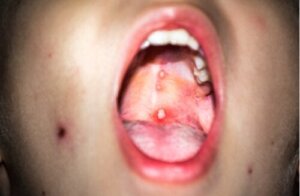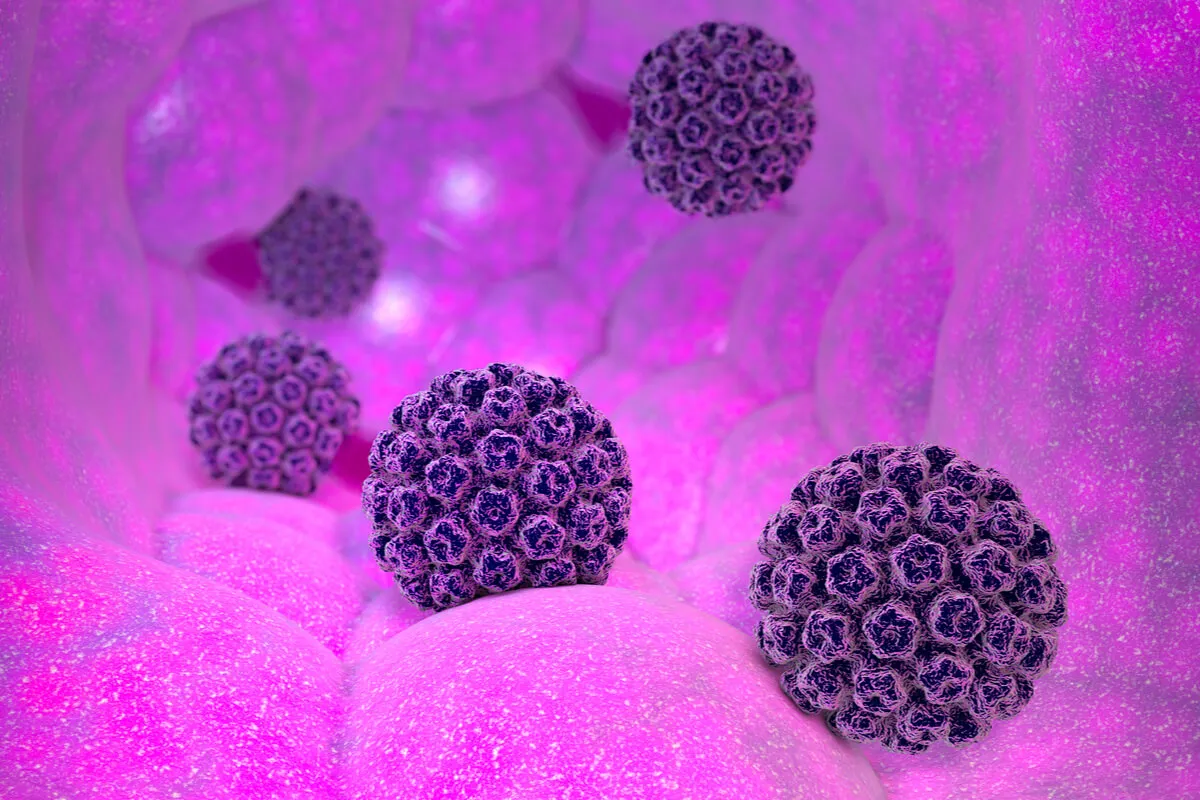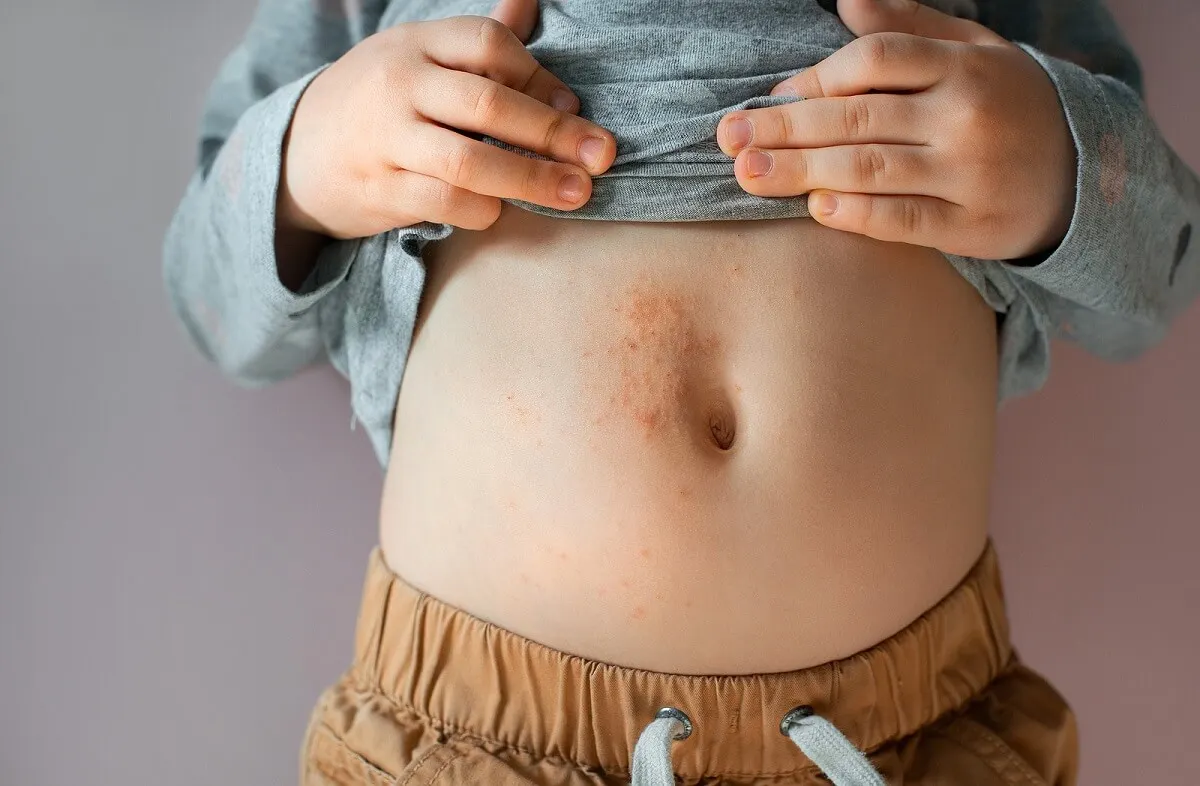Gingivostomatitis in Children: What It Is and What to Do About It


Written and verified by the dentist Vanesa Evangelina Buffa
Oral mucosal lesions may be due to different causes and affect both adults and children. In this article, we’re going to tell you about gingivostomatitis in children, a disorder that causes a lot of discomfort in the mouth of little ones.
This is a fairly common condition in childhood as a result of a viral or bacterial infection. The most common type is caused by the herpes simplex virus.
Mouth lesions and discomfort characterize the condition, which is often a cause of concern for parents. In addition to the discomfort, children may drool excessively, have a fever, and refuse to eat and drink.
What is gingivostomatitis in children?
Gingivostomatitis in children is a condition that’s characterized by the appearance of multiple painful and uncomfortable lesions on the oral mucosa. It most often occurs when the herpes simplex virus type 1 (HSV-1) first infects the mouth of young children.
However, this clinical picture of inflamed mucous membranes and sores can also be caused by other infections. The coxsackie virus and the bacteria Streptococcus and Actinomyces may be responsible, although this occurs much less frequently.
Gingivostomatitis is a disease that occurs in infants and children, generally before the age of 6 years. The causative agent reaches the mouth through saliva. At a stage when the child puts everything in his or her mouth, toys, cups, pacifiers, bottles or any contaminated object can be the route of transmission.
The way it develops and manifests itself depends on many factors:
- Poor oral hygiene
- Diminished defenses
- The habit of kissing the child on the mouth
- A nutritional deficiency, especially in the case of vitamins C and B
- The habit of putting objects or unwashed hands in the mouth
In the case of herpetic gingivostomatitis, once the condition has passed, the virus usually remains stored in the child’s body and remains in a latent state. When situations that favor its reactivation occur , it can cause manifestations again, although milder than the first time.
Decreased defenses, stressful situations, exposure to the sun or cold, trauma and other states of immunosuppression predispose the reactivation of the virus. The lesions usually appear on the lips or inside the mouth and generate a characteristic itching sensation before they are visualized. They look like a cluster of small vesicles.

The symptoms of gingivostomatitis in children
Gingivostomatitis in children manifests with inflammation and multiple painful ulcerations inside the mouth. They are located on the gums, cheeks, on the tongue, palate, and inner lips. However, they can also affect the mucosa of the throat.
The lesions look like small red blisters with liquid content when the process begins. When they break, they give rise to large ulcerations covered by a grayish or yellowish membrane and surrounded by a red inflamed halo.
These ulcers are very painful. This is what generates the child’s discomfort and irritability at all times.
In addition, children with gingivostomatitis may present with the following associated symptoms:
- Bad breath
- Headaches
- Excessive drooling
- Tiredness and general malaise
- A sore throat when swallowing
- A fever higher than 38 °C persistent
- Refusal of food and drink and a lack of appetite
- Enlarged and painful neck lymph nodes
- Red, swollen, inflamed, swollen gums that bleed easily
How is it diagnosed?
In general, to arrive at the diagnosis of gingivostomatitis in children, clinical examination of the mouth is usually sufficient. The characteristics of the lesions and the association of other symptoms guide the professional.
In any case, if the doctor thinks it’s a good idea or believes that the process is not clear, some tests can be performed. Taking a sample of the lesion and requesting a culture is a way to determine the agent that’s causing the process. This will detect whether it is a bacterium, such as strep throat or something viral.
The physician may also perform a biopsy by removing a portion of mucosa from the lesion. This is not the most common option, however, and is usually used in borderline cases to rule out other types of cold sores.
We think you may also enjoy reading this article: LED Teeth Whitening: Advantages, Disadvantages, and Care
How is gingivostomatitis in children treated?
The lesions and discomfort of gingivostomatitis in children usually last between 10 and 18 days. They generally resolve themselves on their own without any treatment.
However, given the discomfort of the picture, the child’s irritability, and the parents’ common concern, the use of some therapeutic measures to calm the symptoms becomes necessary. Thus, medication and home remedies will be a relief that will help the child to feel better until the process culminates.
To treat gingivostomatitis in children, it’s essential to go to the pediatrician to evaluate the child’s mouth and reach an accurate diagnosis. Many conditions may have similar symptoms, but will require other measures.
When the diagnosis is confirmed, the professional may indicate pharmacological treatments for pain, fever and inflammation, such as ibuprofen. Also, if bacteria cause the process, antibiotics may be necessary.
Remember that the child should never be medicated without a doctor’s prescription.
The pediatrician may suggest using local anesthetics that are placed on the mucous membranes to prevent pain at mealtimes. However, their use is not as safe in children, so they’re reserved for specific cases in which the professional considers it appropriate.
Finally, it’s also essential to ensure that the child eats and hydrates adequately while the infection progresses. The discomfort in the mouth often leads the child to refuse food and thus increases the risk of dehydration.
Like this article? You may also like to read: Four Ways to Remove Tartar from Your Teeth
How to care for a child with gingivostomatitis at home
Apart from the treatment suggested by the doctor, there are some home practices that can alleviate the discomfort. These are tips that can help your child feel better:
- Take care of his or her diet: Offering the child fresh and soft foods such as custard, jelly, ice cream, or applesauce helps to reduce the pain. Hard, crunchy, acidic, very salty or spicy foods should be avoided.
- Hydration: Drinking plenty of water helps to prevent complications.
- Rest: It’s important to help the child rest. Naps will contribute to relaxation.
- Oral hygiene: The mouth should be kept clean, and the child should brush their teeth and tongue very gently.
- Prevent contagion: Both the child and his or her caregivers should wash their hands and the objects and utensils that the child puts in his or her mouth correctly and frequently. If the infant attends a day-care center, he/she should rest on those days.
Possible complications
We already told you that gingivostomatitis in children usually lasts about 2 weeks. After that time, the lesions disappear without leaving sequelae.
However, you should know that, although it’s not the most usual, the condition can become complicated. One of the risks is dehydration. The refusal to eat and drink due to the discomfort of mouth sores leads to the child not recovering the lost liquids.
When the process is caused by the HSV-1 virus, there is the possibility of spreading it to other areas of the body. If the eyes are infected, for example, a condition called herpes keratitis develops.
Paronychia is the infection around the nails that also occurs by accidental self-inoculation of the virus from mouth sores. Esophagitis, epiglottitis, encephalitis or pneumonitis are much rarer complications. They usually occur in children who suffer from a deficiency in their immune system.

When to see a doctor
When children have gingivostomatitis, parents should be aware of certain warning signs that may indicate that the process is not progressing well. These include:
- Dizziness
- Convulsions
- Dry mouth and skin
- The absence of tears
- Accelerated respiratory rhythm
- A refusal to eat and drink fluids
- Stomach pain, diarrhea, or rashes
- Excessive tiredness, drowsiness, and sleepiness
- Very high and persistent fever that does not go down with medication
- A persistence or worsening of sores after 2 weeks
- Dry diapers, constipation, or a decrease in daily urination
How to prevent gingivostomatitis in children
Taking care of children’s teeth and gums with proper oral hygiene helps to reduce the risk of contracting this disease. Taking care of the diet and offering a varied and nutritious food that guarantees an adequate supply of vitamins and minerals is also fundamental.
Avoiding physical contact with people who are suffering from an infection is also key to avoid contagion. It’s also important to insist on the handwashing of the patient and caregivers. In addition to cleaning toys, utensils and other objects that the child puts in the mouth should be thoroughly and regularly cleaned.
With good hygiene and eating habits, the risk of suffering from this type of disorder decreases. And at the same time, in doing so, children are being taught to be responsible with their health.
Taking care of this condition
Gingivostomatitis in children is a very annoying and painful picture. Mouth sores prevent children from going about their normal lives. Plus, their parents suffer with them because they don’t know how to relieve them.
Going to the pediatrician and following his recommendations is the best way to help your child. The professional will help you to go through the process with confidence, as they’ll know what to do and how to accompany your child.
This disorder will resolve after a few weeks without leaving after-effects. However, while it lasts, patience and affection will play a key role for the child to be as well as possible.
All cited sources were thoroughly reviewed by our team to ensure their quality, reliability, currency, and validity. The bibliography of this article was considered reliable and of academic or scientific accuracy.
- Muñoz Hiraldo, E., & Morillo Gutiérrez, B. (2017). Infecciones por virus herpes simple. Asoc Española Pediatría Atención Primaria, 1(5), 1-33.
- Acebo Choez, A. Y. (2021). Manejo clínico y farmacológico en pacientes con estomatitis (Bachelor’s thesis, Universidad de Guayaquil. Facultad Piloto de Odontología).
- Crespo Echeverría, B. M., Toledo Pimentel, B. F., Martínez Frometa, M., Machado Rodríguez, M. D. C., Rodríguez Díaz, A. M., & Guevara Martín, H. (2020). Gingivoestomatitis estreptocócica. Revista Cubana de Medicina Militar, 49(2).
- Gleidis, Y., & García, M. (2021, October). GINGIVOESTOMATITIS HERPÉTICA RECURRENTE MÁS HERPES FACIAL. ASOCIACIÓN POCO FRECUENTE. In X Simposio Visión Salud Bucal y IX Taller sobre el Cáncer Bucal 2021.
- González, R. G., Molina, R. B., Rascón, A. N., & Burciaga, R. G. C. (2011). Lesiones frecuentes de la mucosa bucal en niños y adolescentes: Revisión literaria. Revista de la Asociación Dental Mexicana, 68(1), 17-24.
- Ramírez, E. Y. C., Baque, A. V. M., Acosta, A. A. A., & Cevallos, G. B. C. (2021). PREVALENCIA DE PATOLOGÍAS BUCALES EN NIÑOS. Revista Científica Especialidades Odontológicas UG, 4(2).
- Salinas M, Y. J., & Millán I, R. E. (2008). Gingivoestomatitis herpética primaria: Conducta odontológica. Acta odontol. venez, 219-226.
- Proaño Añazco, V. S. (2020). Patologías de mucosa oral en niños de 4 a 12 años (Bachelor’s thesis, Quito: UCE).
- Mojica Lobo, N. D., & Moreno Peña, I. D. (2021). Manifestaciones bucales en pacientes pediátricos bajo terapia oncológica y su protocolo de higiene oral. Revisión de la literatura.
- Daoud, Z., Ramos Amador, J. T., Morillo Gutiérrez, B., & Muñoz Hiraldo, E. (2018). Infecciones por virus del herpes simple 1 y 2. Guía-ABE. Tratamiento de las infecciones en Pediatría. Guía rápida para la selección del tratamiento antimicrobiano empírico. Madrid: Guía-ABE.
- Gayretli Aydin, Z. G., Tanir, G., Genc Sel, C., Tasci Yıldız, Y., Aydin Teke, T., & Kaman, A. (2019). Encefalitis por herpes simple resistente al aciclovir en un niño tratado satisfactoriamente con el agregado de foscarnet: A propósito de un caso. Archivos argentinos de pediatría, 117(1), e47-e51.
This text is provided for informational purposes only and does not replace consultation with a professional. If in doubt, consult your specialist.








